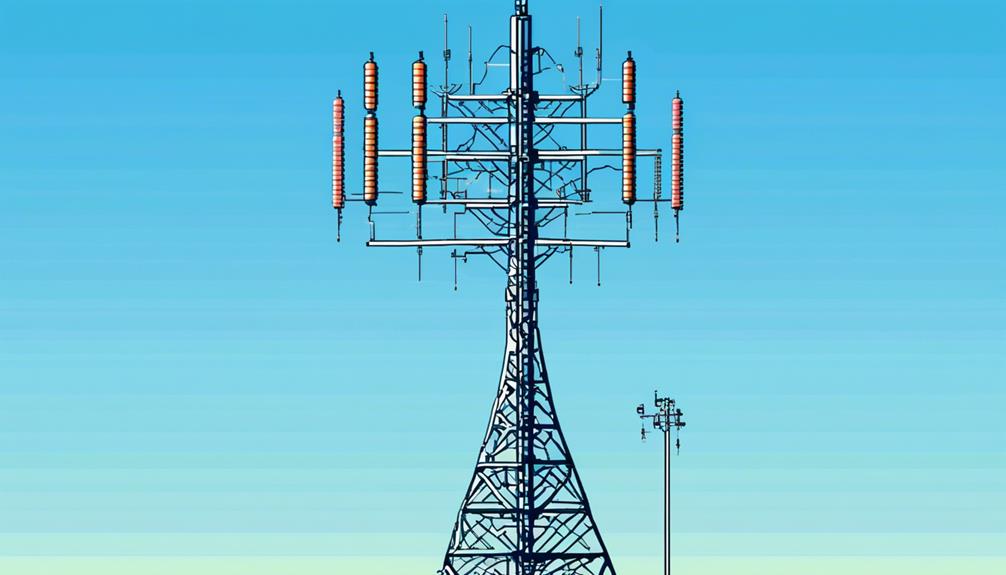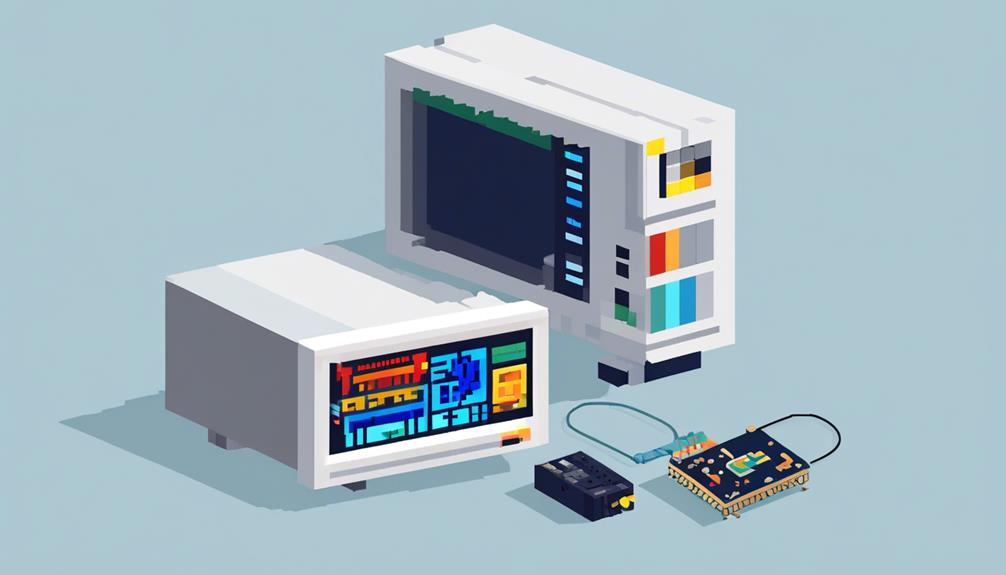Microwave transmission hardware is a crucial element in the field of telecommunications, enabling the transfer of information through the use of microwave signals. This hardware comprises a range of intricate components, including transmitters, receivers, transmission lines, and antennas, among others.
Understanding the intricacies of microwave transmission hardware is vital for professionals in the industry, as it plays a pivotal role in various applications such as point-to-point communication, satellite communication, and mobile communication.
In this discussion, we will explore the fundamental concepts and components involved in microwave transmission hardware, shedding light on topics such as microwave antennas, transceivers, filters, towers, power amplifiers, modulation and demodulation techniques, signal processing, and network synchronization.
By gaining a comprehensive understanding of these aspects, professionals can optimize the performance and reliability of microwave transmission systems, ensuring seamless communication across vast distances.
So, let's embark on this journey to unravel the intricate world of microwave transmission hardware and discover the fascinating mechanisms behind its functioning.
Key Takeaways
- Microwave transmission uses frequencies ranging from 1 to 300 GHz and offers high bandwidth and low interference.
- The antenna is a crucial element in microwave transmission, converting electrical signals into electromagnetic waves.
- Clear line of sight between transmitting and receiving antennas is required for microwave transmission.
- Microwave filters and duplexers eliminate noise and interference, maximize frequency spectrum utilization, and reduce system complexity.
Microwave Transmission Basics

Microwave transmission basics encompass the fundamental principles and technologies utilized in point-to-point communication, satellite communications, deep space radio communications, radars, and radio navigation systems. Microwave transmission involves the use of microwave frequencies, typically ranging from 1 to 300 gigahertz (GHz), to transmit signals wirelessly. This form of transmission is highly effective due to the characteristics of microwave signals, which include high bandwidth and low interference.
The key element in microwave transmission is the antenna. The antenna is responsible for transmitting and receiving the microwave signal. It converts electrical signals into electromagnetic waves and vice versa. The antenna's design and orientation are crucial for achieving optimal signal strength and coverage.
Microwave transmission requires a clear line of sight between the transmitting and receiving antennas. This means that any obstacles, such as buildings or mountains, can obstruct the signal and cause signal degradation or loss. To overcome this limitation, highly directional antennas are used, which focus the signal into a narrow beam. Additionally, the installation locations of the antennas are often elevated to ensure an unobstructed line of sight path.
The frequency of the microwave signal is another important factor in transmission. Different frequencies have different characteristics and limitations. Lower frequency microwaves can travel longer distances but have lower data rates, while higher frequency microwaves have shorter transmission distances but higher data rates. The selection of the frequency depends on the specific communication requirements.
Microwave Antennas
To effectively transmit and receive microwave signals, the key component is the antenna, which plays a crucial role in achieving optimal signal strength and coverage. Microwave antennas are specifically designed for long-distance point-to-point communication in microwave transmission systems. Unlike sectorial antennas, which are used for signal broadcasting, microwave antennas require a direct line of sight between the transmitting and receiving terminals.
One important aspect to consider in microwave antenna design is the occurrence of atmospheric ducting. In rare conditions, atmospheric ducting can cause signal redirection, leading to deviations in the expected signal path. Additionally, signals leaving a microwave antenna spread out to form the Fresnel zone, which must be taken into account when planning for optimal signal reception.
For effective communication, it is necessary for two antennas to have a clear line of sight. This means that any obstacles, such as buildings or geographical features, can significantly impact the signal strength and coverage. Environmental constraints must be carefully assessed to ensure that the antennas are positioned in a way that maximizes the line-of-sight communication.
Microwave antennas are extensively used in various applications, including wireless networks and relay stations. They enable the transmission of signals over long distances, providing reliable and efficient point-to-point communication. To compensate for signal delay, the receiving antenna can correct the timing, ensuring that the transmitted signals are accurately received.
Microwave Transceivers

The crucial component for achieving effective point-to-point communication in microwave transmission systems is the microwave transceiver. Microwave transceivers play a vital role in various applications, including satellite communications, deep space radio communications, radars, and radio navigation systems. Here are some key points to understand about microwave transceivers:
- Microwave transceivers are an integral part of microwave radio relay technology. They enable the transmission of information between two terrestrial points using narrow beams of microwaves, which require a line of sight path.
- Planning for microwave relay involves the use of highly directional antennas and elevated installation locations to ensure a clear line-of-sight path. This ensures the efficient and reliable transmission of signals.
- Microwave technology has evolved rapidly since its development after World War II. It has been widely used for telephone calls, television signals, and computer data transmission. In recent years, there has been an increase in microwave spectrum usage for wireless networks and direct-broadcast satellites.
- However, microwave transmission does have its limitations. The propagation of microwaves requires a clear line of sight, which can be obstructed by buildings, terrain, or other obstacles. The practical transmission distance is also limited to a few kilometers due to atmospheric attenuation and interference.
- To overcome these limitations, careful planning and optimization of microwave transceivers are necessary. This includes selecting appropriate frequencies, adjusting antenna heights and angles, and implementing effective interference mitigation techniques.
Microwave transceivers are a critical component of microwave transmission systems, enabling efficient point-to-point communication and supporting various applications. Understanding their capabilities and limitations is essential for designing and deploying reliable microwave networks.
Microwave Filters and Duplexers
A crucial element in the efficient control and management of microwave signals in communication systems is the implementation of microwave filters and duplexers. These components are essential in optimizing signal quality and spectral efficiency in microwave transmission.
Microwave filters play a vital role in selecting specific frequencies and rejecting unwanted ones in a signal. They are used to eliminate noise and interference, ensuring that only the desired frequencies pass through. Filters are designed to have a specific bandwidth, which allows for the transmission of signals within a certain range of frequencies. By effectively suppressing unwanted frequencies, filters help improve the overall performance and reliability of microwave communication systems.
Duplexers, on the other hand, enable the transmission and reception of signals on the same antenna. This allows for bidirectional communication, where signals can be sent and received simultaneously. Duplexers are crucial in maximizing the utilization of the available frequency spectrum, as they enable the sharing of a single antenna for both transmission and reception. They also help in reducing the size and complexity of microwave communication systems, as separate antennas for transmission and reception are not required.
Microwave Towers and Mounts

Microwave towers and mounts serve as critical infrastructure for supporting the antennas and equipment required for the precise and reliable transmission of microwave signals in point-to-point communication systems. These towers and mounts are strategically located to ensure clear line of sight communication between transmitting and receiving stations, which is essential for effective signal transmission. The design of microwave towers and mounts prioritizes stability, durability, and the ability to withstand environmental factors such as wind, rain, and temperature variations.
Here are five important aspects to consider when it comes to microwave towers and mounts:
- Signal propagation: Microwave towers and mounts are strategically positioned to establish a direct microwave link between the transmitting and receiving stations. This line of sight communication is crucial for maintaining reliable signal transmission over long distances.
- Frequency reuse: To maximize the utilization of available frequency bands, microwave towers are often designed to support multiple parabolic antennas. This allows for the reuse of frequencies, increasing the capacity and efficiency of the communication system.
- Hardware support: Microwave towers and mounts are engineered to support various hardware components, including microwave antennas, transmission lines, and other essential equipment. This ensures the reliable operation of the entire microwave transmission system.
- Environmental considerations: Microwave towers and mounts are designed to withstand harsh environmental conditions. They are constructed using materials that can withstand extreme temperatures, strong winds, and heavy rainfall, providing durability and longevity.
- Optimal coverage: The selection and installation of microwave towers and mounts are crucial for achieving optimal signal propagation and coverage. Factors such as tower height, location, and antenna placement are carefully considered to ensure reliable and efficient communication network coverage.
Microwave Cables and Connectors
Microwave cables and connectors play a crucial role in the transmission of signals within microwave communication systems.
Different cable types are available to suit various system requirements, such as low loss or flexibility.
Compatibility between connectors ensures proper mating and reliable signal transfer.
Additionally, high-quality cables and connectors help prevent signal loss, maintaining optimal system performance.
Cable Types
What are the different types of cables and connectors used in microwave transmission to effectively handle high-frequency signals?
Microwave cables and connectors are specifically designed to handle high-frequency microwave signals effectively. Different types of cables, such as semi-rigid, flexible, and corrugated, are used based on specific application requirements.
Semi-rigid cables provide excellent shielding and are ideal for high-frequency applications. Flexible cables, on the other hand, offer ease of installation and flexibility in routing. Corrugated cables are suitable for outdoor installations due to their robust construction and weather resistance.
Connectors play a crucial role in ensuring a secure and reliable connection between microwave transmission components. The choice of cable type and connector is determined by factors like signal frequency, power levels, environmental conditions, and installation constraints.
Proper installation, maintenance, and handling of microwave cables and connectors are essential to ensure optimal performance and signal integrity.
Connector Compatibility
Connector compatibility is a crucial aspect to consider when working with microwave cables and connectors in order to ensure optimal system performance. Different microwave cables and connectors may have specific compatibility requirements, and mismatched connectors can lead to signal loss and reduced system performance. To address this issue, adapters may be used to ensure compatibility between different types of connectors. It is important to verify the compatibility of connectors with the microwave hardware being used, including the transmission hardware, receiving antenna, transmitting antenna, and other components involved in line-of-sight communication. The table below provides an overview of common microwave connectors and their compatibility requirements:
| Connector Type | Frequency Range | Compatible Cable Types |
|---|---|---|
| SMA | DC – 18 GHz | Semi-rigid, flexible |
| N | DC – 11 GHz | Semi-rigid, flexible |
| TNC | DC – 11 GHz | Semi-rigid, flexible |
| BNC | DC – 4 GHz | Flexible |
| Type F | DC – 1 GHz | Coaxial |
Signal Loss Prevention
To ensure optimal system performance and prevent signal loss, proper installation and maintenance of microwave cables and connectors are crucial. Here are five key points to consider for signal loss prevention:
- Select the appropriate type of microwave cable and connector based on the specific application and environment. This helps minimize signal loss and ensures reliable transmission.
- Regularly inspect and test microwave cables and connectors to identify any issues that may cause signal degradation. Prompt maintenance and repair are essential to maintain optimal performance.
- Use high-quality materials and components for microwave cables and connectors. This reduces signal loss and enhances the overall reliability of the system.
- Implement proper grounding techniques and shielding for microwave cables and connectors to minimize interference and signal attenuation.
- Consider adaptive modulation techniques to compensate for path loss in microwave links. This helps optimize signal transmission and maintain high data rates.
Microwave Power Amplifiers
Microwave power amplifiers are indispensable components in microwave transmission systems. They serve the critical function of boosting the power of microwave signals for long-distance communication. These amplifiers are designed to operate within the microwave frequency range, typically from 300 MHz to 300 GHz.
Their role is essential in maintaining signal integrity and quality over long transmission distances, enhancing the reliability and efficiency of microwave communication systems.
Microwave power amplifiers are specifically engineered to overcome signal loss and ensure that the microwave signals can be transmitted over long distances without significant degradation. They are capable of amplifying weak microwave signals to higher power levels, compensating for losses that occur during transmission through cables, connectors, and other components of the microwave system. This amplification is crucial for achieving the desired signal strength and ensuring reliable communication.
Microwave power amplifiers come in various types, including solid-state amplifiers and traveling wave tube amplifiers (TWTAs). Solid-state amplifiers are based on semiconductor technology and offer advantages such as compact size, high efficiency, and wide bandwidth. TWTAs, on the other hand, are vacuum tube-based amplifiers that provide high power output and excellent linearity.
In microwave transmission systems, power amplifiers are typically placed at strategic points along the transmission path to compensate for signal losses. This ensures that the signal strength is maintained at an optimal level for successful communication. Additionally, power amplifiers are often equipped with various control mechanisms and protection features to safeguard against excessive power levels and potential damage to the system.
Microwave Modulation and Demodulation

Microwave modulation and demodulation are crucial processes in the field of microwave communication.
Modulation involves encoding information onto a carrier signal.
Demodulation is the reverse process of extracting the original information from the modulated signal.
Various modulation techniques such as amplitude modulation, frequency modulation, and phase modulation are used to transmit information effectively over microwave links.
Modulation Techniques
The alteration of a carrier wave's characteristics is a fundamental process in microwave communication known as modulation. Modulation techniques play a crucial role in the transmission of information through microwave transmission hardware. Here are some key points about modulation techniques:
- Amplitude Modulation (AM): This technique involves varying the amplitude of the carrier wave to encode information. It is commonly used in point-to-point microwave communication systems.
- Frequency Modulation (FM): FM modulation alters the frequency of the carrier wave to convey information. It offers better noise immunity and is often used in applications where signal quality is critical.
- Phase Modulation (PM): PM modulates the phase of the carrier wave to encode information. It is widely used in digital microwave communication systems due to its efficiency and robustness.
- Demodulation: Demodulation is the process of extracting the original information from the modulated carrier wave.
- Suitable Techniques: Different modulation techniques are employed based on application requirements, transmission environments, and frequency ranges.
Understanding modulation techniques is essential for efficient and reliable microwave communication.
Demodulation Process
The demodulation process is a crucial step in microwave communication systems, as it involves extracting the original signal from the modulated carrier wave.
In microwave transmission, the demodulation process is performed using various techniques to accurately recover the transmitted data or information. One commonly used technique is envelope detection, where the amplitude variations of the modulated carrier wave are detected and used to reconstruct the original signal.
Another technique is synchronous detection, which involves synchronizing the demodulator with the carrier wave to extract the original signal. Coherent detection is also used, where the phase and frequency of the carrier wave are tracked to recover the original signal.
The demodulation process is essential for ensuring reliable communication in microwave transmission systems, especially in frequency bands that require line of sight communication and where the signal strength can be affected by obstacles and interference.
Microwave Signal Processing
Signal processing plays a critical role in achieving efficient and reliable transmission of microwave signals over long distances. Microwave signal processing involves a series of steps to ensure the signal is encoded, modulated, amplified, and decoded accurately. Here are five key aspects of microwave signal processing:
- Encoding and modulation: The microwave signal is encoded with the desired information and modulated to be suitable for transmission. This process involves converting the input signal into a format that can be transmitted using electromagnetic waves.
- Amplification: Before radiation through an antenna, the microwave signal is amplified to compensate for losses in the transmission path. This ensures that the signal strength is sufficient for reliable reception.
- Repeater usage: In long-distance point-to-point microwave transmission, repeaters are used to boost the signal power. Repeater stations receive the microwave signal, amplify it, and retransmit it towards the receiver, extending the transmission range.
- Down-conversion and decoding: At the receiving station, the microwave signal is down-converted to a lower frequency for further processing. The signal is then decoded to extract the original information for use.
- Adaptive techniques: To optimize microwave signal processing, various adaptive techniques are employed. These include adaptive modulation, which adjusts the modulation scheme based on the channel conditions, and transmit power control, which regulates the signal strength based on the received signal quality.
Microwave signal processing is crucial for maintaining signal integrity and quality over long-distance transmission. The high frequency of microwave signals and the use of narrow beams, such as in line of sight (LOS) systems, require precise processing techniques to ensure reliable communication. By encoding, modulating, amplifying, and decoding the microwave signal effectively, signal processing helps achieve efficient and robust microwave transmission.
Microwave Network Synchronization

Microwave network synchronization is a critical aspect of maintaining precise timing and coordination among network elements in order to ensure the integrity and reliability of microwave communication systems. Synchronization is crucial for efficient data transmission and reception across the network, allowing for seamless connectivity and handover between different network elements. By achieving precise synchronization, interference can be avoided, and signal quality can be maintained.
To better understand the importance of microwave network synchronization, let's explore the key factors that need to be considered:
| Factors | Description |
|---|---|
| Frequency | Synchronization ensures that all network elements operate at the same frequency, enabling seamless communication. |
| Link Length | Synchronization compensates for propagation delays caused by the link length, ensuring accurate timing. |
| Line-of-Sight | Maintaining synchronization is crucial for point-to-point microwave links, where obstacles can disrupt signals. |
Microwave network synchronization relies on precise timing references and protocols to ensure accurate coordination. Different synchronization techniques, such as synchronous Ethernet or Precision Time Protocol (PTP), can be used to achieve this. These techniques allow for the distribution of precise timing signals throughout the network, ensuring that all network elements are synchronized.
Frequently Asked Questions
How Does a Microwave Transmission Work?
Microwave transmission works by utilizing electromagnetic waves in the microwave frequency range to transmit data or signals wirelessly. It involves line of sight communication, where the signals propagate in a straight line between the transmitting and receiving antennas.
The antenna design and functionality are crucial in achieving effective signal transmission. Modulation techniques are employed to encode the data onto the microwave carrier wave.
Challenges in microwave transmission include atmospheric attenuation and distance limitations. However, microwave transmission offers advantages such as high bandwidth capacity, low latency, and suitability for various industries including telecommunications, broadcasting, and transportation.
What Are the Two Types of Microwave Transmission?
The two types of microwave transmission are terrestrial microwave transmission and satellite microwave transmission.
Terrestrial microwave transmission involves communication between two terrestrial points using narrow beams of microwaves and requires a line of sight path.
On the other hand, satellite microwave transmission refers to communication through satellites using microwaves for broadcasting, telecommunication, and other purposes.
Both types of microwave transmission are widely used for point-to-point communication, satellite communication, and long-distance data transmission.
What Are the Three Basic Components in a Microwave Link?
The three basic components in a microwave link are the transmitter, receiver, and transmission lines.
The transmitter processes and encodes the signal before up-converting it to microwave frequency, while the receiver captures the microwave signal and decodes it to retrieve the original information.
Transmission lines, such as coaxial cables or waveguides, are used to transfer the microwave signal between the transmitter and receiver.
These components are crucial for signal propagation, minimizing interference, optimizing performance, ensuring line of sight, and planning for microwave link capacity.
Regular maintenance of the microwave transmission equipment is also important to ensure optimal functionality.
What Is the Basic of Microwave Transmission?
Microwave transmission is a communication method that relies on the use of microwave signals to transmit information. It is based on several key components and principles.
One of the essential aspects of microwave transmission is frequency allocation. Different frequency bands are allocated for specific types of communication, such as point-to-point links or satellite communication.
Line of sight propagation is another crucial principle in microwave transmission. Microwave signals travel in straight lines and require an unobstructed path between the transmitter and receiver. Obstacles like buildings or mountains can disrupt the signal.
Antenna design plays a significant role in microwave transmission. Different types of antennas, such as parabolic dish antennas or horn antennas, are used to focus and direct the microwave signals in the desired direction.
Modulation techniques are employed to encode information onto the microwave signal. These techniques include amplitude modulation (AM), frequency modulation (FM), and phase modulation (PM).
Signal attenuation is a challenge in microwave transmission. As the signal travels through the atmosphere, it experiences loss due to factors like rain, fog, or atmospheric absorption. Techniques like power control and adaptive modulation help mitigate this issue.
Multiplexing methods are used to transmit multiple signals over a single microwave link. Time-division multiplexing (TDM) and frequency-division multiplexing (FDM) are commonly employed techniques.
Error correction techniques ensure the accuracy of the transmitted information. Forward error correction (FEC) and automatic repeat request (ARQ) are examples of error correction methods used in microwave transmission.
Link budget analysis is performed to determine the feasibility and performance of a microwave link. It involves calculating various factors like signal power, noise, and link margin to ensure reliable communication.

